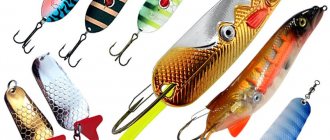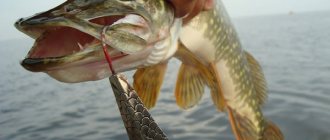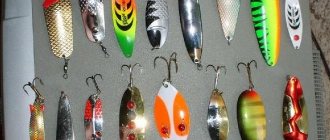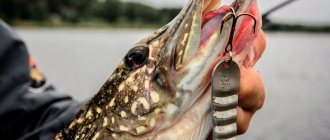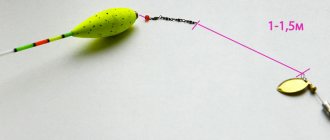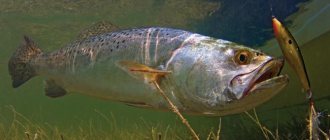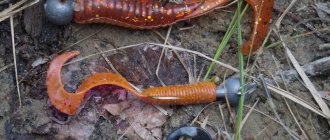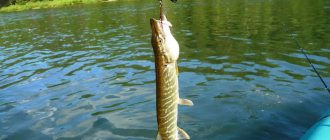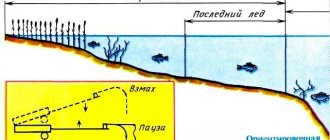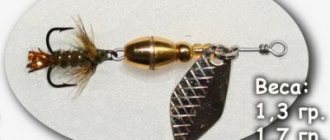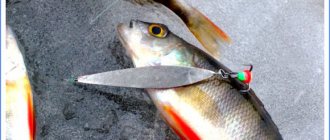Types of fish
Trout is a species of predatory freshwater fish that belongs to the salmon family. In the reservoirs of Russia you can find rainbow, lake and brook trout. And the last two species of this predator live in the Republic of Karelia. Lake trout, or brown trout (the name comes from the Sami word kuu︢dz︣a through the Finnish kums) are distinguished by their yellowish-brownish mottled color and shimmering scales. The stream, or “pied”, is distinguished by a brownish color with numerous dark and red markings on the body. This coloring is associated with the fish living in fairly dark water.
Trout
Of greatest interest to the sports fisherman are sea trout (or brown trout), lake trout and brook trout (or speckled trout).
Lake trout is found in Lake Ladoga and Onega, as well as cold-water lakes in Karelia and the Kola Peninsula. Its special forms live in the high-mountain lakes of the Caucasus and Transcaucasia. It feeds mainly on small fish, as well as insects and their larvae.
Brook trout, or pied trout, inhabits many fast and cold-water rivers in the European part of Russia. Common in Karelia, on the Kola Peninsula, in the Baltic Sea basin. There are in the Caucasus and Crimea.
It differs in appearance and color from other trout. Characteristic are red or orange spots surrounded by a light rim. Brook trout are very similar to juvenile lake trout from the river life period. Even specialists, not to mention amateur fishermen, find it difficult to distinguish between them. The color, shape of spots and their number in brook trout vary depending on the characteristics of the reservoirs. Usually the weight is 300-500 g, occasionally individuals weighing 1-2 kg are found.
Trout spend most of their lives sedentary. It makes small movements in search of spawning areas and sometimes during floods, rising upstream in both cases. Spawning even in the same river continues from October to February, at a water temperature of 1-6 degrees. Spawning sites are shallow and fast riffles.
Best biting period
It feeds throughout the year, except for the spawning period, the hottest days of summer and sudden turbidity of the water. In summer it fattens mainly in the morning and evening. In the north it feeds on white nights. In spring and autumn, as well as in cold weather, it feeds almost all day.
Favorite bait
The food is small crustaceans, insects and their larvae, fish eggs, and for large trout sometimes small fish, mainly minnows.
Habitats
In summer, small trout stay in small groups on rapid rivers, choosing quiet areas. The large one prefers deep places near shelters, trees fallen into the water, and large stones. He likes to stand on dumps - the transition of shallows into the depths, near steep banks into which a stream of water hits, and on the border of fast and slow currents. From her shelter she makes a swift dash to grab an insect that has fallen into the water. Brook trout are very shy and will immediately swim away if the angler is not careful enough to move along the shore.
Fishing for trout in ponds
Igor 05/21/2015
fishingday.org
Description of the breed
A popular fish from Karelia, trout, is quite widespread. Although it lives in both salt and fresh waters, it comes exclusively to freshwater bodies to spawn. In addition to its natural habitat, this breed is found on special farms where it is bred on an industrial scale.
Externally, Karelian trout looks like this:
- The body is elongated, dotted with small scales with a shiny tint, and there are dark inclusions.
- The head is medium-sized, elongated, in the form of a triangle, with small eyes.
- The fins have two compact dorsal fins: the main one and the adipose or false one.
As often happens in nature, female trout in Karelia are usually larger than males. And besides, they have fewer teeth. Regardless of gender, the shape of the jaw gradually changes with age, becoming more and more curved upward.
The color of a predator depends on various factors. Here are the species characteristics, the habitat and even the time of year. Many reservoirs in the republic have a peat bottom and a characteristic water color. Therefore, salmon living in such reservoirs are distinguished by a dark shade, even deep black. In clear water, individuals are usually found with a clear silver color and dark markings, often with a light border. The abdomen of such fish has a yellowish or cream color. Thus, when living conditions change, the color of the flock’s scales changes over time. And by the spawning period it becomes brighter and more saturated.
Salmon family
1. Pink salmon 2. Salmon, Atlantic salmon 3. Lake salmon 4. Brown trout 5. Lake trout 6. Brook trout 7. Red palia 8. Blackmouth palia 9. White salmon 10. European vendace 11. White Sea vendace 12. Whitefish 13. Peled
Pink salmon
Salmon belonging to the genus Pacific salmon. This is a new invasive species for the fauna of Karelia. Work on the acclimatization of pink salmon in the north of our country (Murmansk region) began in 1956. The caviar delivered from the Far East was incubated in fish hatcheries, and the juvenile pink salmon were released into the rivers in the spring of the following year. Since the beginning of the 60s, work on breeding pink salmon has been launched in Karelia.
Along the White Sea coast of Karelia, pink salmon enter the same rivers that are spawning grounds for salmon. The first entries of pink salmon into the river can take place as early as the end of June, but until mid-July they usually rise in single specimens. The mass migration of pink salmon occurred on different dates from the end of July to the beginning of September. The catches included specimens ranging from 400 g to 3.7 kg, the average weight of females was 1.35 kg, the average size was 49.2 cm; males are slightly larger: weight 1.44 kg, size 50.1 cm. The fertility of pink salmon varied over the years from 1600 to 1700 eggs.
Spawning of pink salmon in our rivers occurs somewhat earlier than the spawning of salmon, at the end of September - beginning of October. As a rule, the spawning grounds of both species do not combine. In addition, pink salmon usually do not rise as high in our rivers as salmon. As a food product, pink salmon is somewhat inferior in meat quality to local salmon, but undoubtedly it should be considered one of the most valuable fisheries.
Salmon, Atlantic salmon
Salmon is the most valuable species of our ichthyofauna. It is distributed throughout the White Sea coast of Karelia, where it enters 14 tributaries to breed, some in single specimens.
White Sea salmon is represented by two ecological forms - winter and spring, differing in the time of entry into rivers for reproduction and the state of reproductive products. The winter form (also called “autumn” salmon) enters the rivers from late summer and continues until late autumn. The reproductive products of this form are poorly developed and mature only by the fall of next year. In winter, its movement in rivers usually stops. In the spring, the flow of the river resumes. The spring form (also known as summer salmon) comes from the sea with well-developed reproductive products and reproduces in the autumn of the same year.
The size of salmon depends on its membership in one or another biological group. Some specimens of “autumn” salmon from the Kemi River reached 16 kg in weight. In other areas of distribution, salmon of larger sizes are not uncommon. For example, on the Pechora River specimens up to 40 kg were caught, and at the mouth of the Neman River - even up to 46 kg.
Salmon spawns in the fall (October). Fecundity (the number of ripe eggs} in salmon is relatively small - even large females rarely have more than 20 thousand eggs. Many of the fish die after the first spawning, but some of them survive in the same fall or, more often, in the spring after the ice drifts, and roll off in the sea (they are called “walchaks”) and can re-participate in spawning.
Juvenile salmon spend 2-3 years in the river, in rare cases up to 5 years, then leave it and go to sea. But some of the young males remain in the river and, although they hardly increase in height, they reach sexual maturity here and take part in spawning along with the large males that came from the sea.
At sea, salmon switches to carnivorous feeding, grows quickly and can travel great distances from their native rivers in search of food. After spending from one to three years fattening (fed) in the sea, the salmon returns to the river where it was born and grew during the first years of its life. In general, the life expectancy of salmon is short - no more than 5 - 8 years. Rarely does she manage to spawn more than twice, although the literature describes a case of a female caught in Scotland participating in spawning five times.
Salmon is a fast and strong fish. As tagging results have shown, during sea migration it can reach speeds of up to 100 km per day. When entering a river, the pace of movement is significantly reduced - you have to overcome not so much the current as numerous rapids and waterfalls.
The nutritional qualities of salmon do not need advertising; among the contenders for “red fish” it rightfully takes the lead. Unfortunately, salmon numbers have declined sharply. To maintain its reserves, artificial breeding in special factories is widely used in our country and abroad.
lake salmon
In some lakes of Karelia there lives a special freshwater form of salmon - lake salmon. It does not go into the sea, but feeds in the lake, and goes to the rivers flowing into the lake to spawn. Lake salmon undoubtedly owes its origin to its marine relatives.
If we do not take into account the peculiarities of the “biography” associated with the sea, then both in lifestyle and in appearance lake salmon are very similar to the original marine form. Like sea salmon (salmon), during the period of river travel to spawning grounds, the color of lake salmon from silver becomes dark, first with a purple tint, then dark brown or almost black. The skin of such fish thickens, the scales sink into the skin, and in males a characteristic protrusion—a hook—appears on the lower jaw. Like salmon, lake salmon do not feed in the river, and their internal organs undergo significant changes: the intestines usually lose their digestive function, the spleen increases in size, and the activity of certain enzymes increases in the muscles and liver.
The timing of the spawning run of lake salmon in different rivers differs significantly. For example, the Shuya salmon (Lake Onega) mostly rises into the river from the lake in the spring and in the first half of summer (May-June), and in many rivers of the northern Ladoga region (Khiitola, Ekhala, Fuksa), Segozero (Luzhma) and the same Onega lake (Lizhma) the summer-autumn cycle prevails. Spawning occurs in October, at a water temperature of 2 - 6'C, in sections of rivers characteristic of salmon - small rapids and riffles with gravel and pebble soil.
The juveniles live in the river from two to four years, then slide into the lake. The sizes of downstream juveniles, as well as adult fish, differ significantly for different rivers, and there is no pronounced relationship between these indicators. For example, in large Shuya salmon (the average weight of adult fish is 6.5 kg, but individuals of 10 - 11 kg are not uncommon), downstream fish have sizes from 12 to 15 cm and an average weight of 26 g, and in the much smaller Segozero salmon (average weight 3. 2 kg) downstream fish are much larger - from 35 to 50 g.
The lifespan of lake salmon in the lake varies even more than that of sea salmon - from one year to nine years. The favorite food of salmon in the lake is smelt and vendace. The feeding movements of salmon during this period are mainly associated with feeding and spawning migrations of these fish. But often other types of fish can be found in salmon food - three-spined stickleback, bleak, and juvenile whitefish.
In Karelia, the freshwater form of salmon lives in the largest lakes (Ladoga, Onego, Segozero, Vygozero, Kuito lakes), as well as in some medium-sized lakes (Nyuk, Kamennoe, Sandal, Yanisjärvi). Occasionally, salmon are caught in lakes Vodlozero and Vedlozero, but they do not live here permanently, but penetrate into these lakes through drainages - the Vama and Vidlitsa rivers. In the total fish catches in the inland waters of Karelia, lake salmon accounts for a small share. But it is a particularly valuable fish of our ichthyofauna and therefore is one of the main commercial objects.
Brown trout, migratory trout
A close relative of sea salmon is salmon. Brown trout differs from salmon primarily in color: its body is covered with numerous black spots located on the sides of the entire body. There are also differences in the structure of the body: the caudal fin of brown trout is straight along the rear edge or has a very small notch. Its breeding plumage is less pronounced than that of salmon. During the spawning period, the jaws bend and elongate less.
On the White Sea coast of Karelia, brown trout enter the same rivers as salmon to breed, but the start of the migration is observed somewhat later than that of salmon—in August-September. Unlike salmon, during the period of river migration, brown trout continue to feed, but less intensively than at sea. Brown trout, like all our salmon, spawn in the fall - in October-November, laying eggs on pebble-sandy soil. Brown trout caviar is quite large, up to 5 mm. One female lays about 3 - 4 thousand eggs, which after fertilization buries in the ground. After spawning, brown trout remain in the river for almost a year and only enter the sea in the summer of next year.
In the sea, brown trout live from one to four years, reaching a length of 50 - 70 cm and a weight of 3 - 4 kg. There are isolated cases of catching larger specimens - up to 1 m in length and 12 kg in weight. In general, brown trout grow more slowly than salmon. As a food product, trout is highly valued, although the quality of meat is somewhat lower than salmon.
Lake trout
Lake trout, or lake trout, is a freshwater form of sea trout, to which it owes its origin. Lake trout is found in many large and medium-sized lakes in Karelia, sometimes simultaneously with lake salmon. In the large northern lakes of the republic, Pyaozero and Topozero, lake trout is the only representative of the noble salmon genus, since lake salmon do not live here. In appearance, lake trout are similar to sea trout. In catches, lake trout most often weigh 2–3 kg; occasionally, much larger specimens are caught.
Like other salmon, lake trout enter rivers to breed. In terms of choosing spawning sites, trout are more unpretentious and can breed even in streams with very swampy water. It is not possible to identify more or less clear dates for the spawning migration of trout. In large rivers (Shuya, Vodla) its flow can take place from the end of May to September, that is, throughout the entire summer period. In small rivers and streams, the beginning of the run is often pushed back to the second half of summer, and the main run occurs in the fall (September - early October).
The fertility of Pyaozersk lake trout is on average 6 thousand eggs, Ladoga - 4 - 5 thousand. The spawning process is similar to the spawning of other salmon - lake salmon, salmon, sea trout. Young lake trout live in the river for up to 5 years, although most of them migrate into the lake already in the third year of life. In terms of meat quality, lake trout is not much inferior to salmon. But there is no special trout fishery in Karelia, since its numbers are small everywhere.
Brook trout
In numerous small rivers and streams of Karelia, a small variety of trout is common - brook trout, or pied trout. It is quite numerous in small tributaries of the northern Ladoga region and in tributaries of relatively large rivers of this basin (Olonka, Vidlitsa, Tuloksa, etc.), in many streams and rivers of the Lake Onega basin (Orzega, Derevyanka, Filippa, Tuba, Nemina, etc.). In all cases, this fish prefers flowing reservoirs with fast currents and rocky soil.
With its color, brook trout somewhat resemble juvenile lake salmon and salmon, known during the period of river life under the name “parr” and often mistakenly mistaken by the population for trout. But brook trout differs from juvenile salmon in a large number of small spots - black, orange and red, located on the sides of the body, on the fins and usually surrounded by a light rim.
Brook trout feed on small crustaceans and aquatic insect larvae, as well as adult insects falling into the water and flying above the water. Large trout can become predatory and eat small fish (minnows, sculpin gobies), tadpoles and adult frogs.
Brook trout, like other trout in Karelia, breeds in the fall, mainly in October. Although brook trout lives in one body of water all its life, it travels to spawn - it climbs to the upper reaches of its streams and rivers. The fertility of brook trout is small compared to other forms - 200 - 1500 eggs. In Karelian reservoirs, brook trout is a small fish, usually not exceeding 20 cm in length and 50 - 100 g in weight. Brook trout has no commercial significance.
Palia laudanum, red
The only representative of the genus of loaches in Karelian inland waters. The number of reservoirs in which palia lives is hardly inferior to the number of reservoirs where lake salmon or lake trout live. However, due to its small number and more complex method of extraction, palia often remains an insufficiently known fish even for the local population. In the largest lakes of Karelia, Ladoga and Onega, two forms of palia live: ludnaya, or red, and pit, or kryazhevy. The last form of palia is also called sera. The forms differ in appearance and lifestyle.
Ludwig has a dark color on the dorsal fin and the upper half of the body, usually dotted with light spots of various shapes and sizes. The spots, although of a different color, often extend onto the dorsal fin.
Ludary palia is a fairly large fish. In catches, its average weight is 2 - 3 kg, but there are known cases of catching specimens weighing 5 and even 8 kg. Yamnaya palia is lighter than ludina, its color is more uniform, there are no bright spots on the body, but near the lateral line, dark areas on the sides of the body alternate with light ones. The size of the pit paliya is smaller than the ludnaya one: its usual weight is 0.8 - 2 kg, only rare specimens reach 4 kg. In Segozero (Medvezhyegorsky district), another variety of palia was discovered - blackmouth. This is the smallest of our paliyas. Its length does not exceed 50 cm, weight is 200 - 950 g.
Palia is a cold-loving fish. This explains its commitment to vast deep-sea reservoirs, where even in summer low water temperatures (10 - 12'C) remain at depth. The greatest depths, up to 70-150 m, are inhabited by the Yamnaya Palaia; red palia lives at a depth of 30 - 40 m. The usual habitats of palia are the slopes of underwater rocky shallows and the depressions between them.
An adult palia is a typical predator. In its diet, one can notice a seasonal change in food items. In the summer, when palia sticks to deep areas, smelt predominates in the food, and with the approach of autumn and a drop in water temperature, the main role passes to vendace. Often other fish are found in Palia's food - stickleback, bleak, small whitefish, as well as large crustaceans - mysids and pallasea. Palia does not stop feeding in winter. Unlike other salmonids, palia not only spends its feeding period (fattening) in the lake, but it also reproduces here. In Lake Ladoga, the main spawning grounds of palia are located to the west of the Valaam archipelago, near the islands of Vossinansaari, Rahmansaari, in the Kurkijoki Gulf; in Lake Onega - on the luds near the Ivanovo Islands, Monatsky Ridge, on the Jordan lud, in Tolvuiskoye Onego, on the Kalgostrovsky luds, in the northwestern part of the lake.
Spawning time depends on hydrometeorological conditions. It can begin as early as the second half of September, at a water temperature of 9 - 10'C, and end in November, when the temperature drops to 6'.
The fertility of palia is relatively low, on average about 4500 eggs. Sexual maturity occurs at 7–9 years of life. Palia eggs are quite large, up to 5 mm, and egg development continues throughout the winter. In addition to the Onega and Ladoga lakes, in Karelia, palia lives in a number of large lakes - Topozero, Pyaozero, Segozero, as well as in relatively small lakes - Palya, Maslozero, Tumasozero, Syargozero, etc.
In terms of meat quality, palia is only slightly inferior to salmon and trout.
Palia blackmouth
Segozero, average weight about 0.6 kg. Not used by fisheries.
Nelma
Systematically, nelma is close to white fish (it is its subspecies), living in the Volga-Caspian basin. This is one of the most valuable commercial fish of our North, especially its Asian part. Nelma is widespread along the entire Asian coast of the Arctic Ocean to the Bering Sea. The western border of its habitat is the White Sea, but here it is currently very few in number.
In color, nelma is similar to large whitefish: a silvery body with large scales, devoid of spots.
Nelma is a fairly large semi-anadromous fish. In catches, it is not uncommon to find individuals up to 1 m long and weighing 6–10 kg. There are known cases of catching larger specimens - 141 cm long and weighing 40 kg.
In the sea, salmon does not make large migrations; it sticks to desalinated bays adjacent to the mouths of large rivers. Here it feeds mainly on small fish - herring, capelin, etc. To reproduce, nelma enters rivers and, when moving to spawning grounds, covers considerable distances from the mouth, rising to the upper reaches of rivers. In the White Sea basin, nelma came to spawn in the Northern Dvina, Onega, and from the Karelian rivers - in the Kem, Vyg, Suma, and Nyukhcha. However, the entry of nelma into all the White Sea rivers of Karelia was limited to single individuals.
White salmon spawn in the fall, in September-October, on rifts with rocky soils. Juveniles begin to migrate from rivers already in the first year of life, but some of them live in rivers for up to three years. Compared to other salmon, nelma lives quite a long time, over 20 years. She also reaches sexual maturity late, usually not earlier than 10 years of age.
European vendace
The most widespread species of the salmon family, close to whitefish. It differs from juvenile whitefish, with which vendace is sometimes confused, by thin, easily falling scales, as well as by an upper mouth, with the lower jaw protruding beyond the front edge of the upper.
In Karelian lakes vendace is quite widespread. This is the main commercial fish of Karelia. Like whitefish, vendace forms a number of forms and has its own morphological characteristics in almost every body of water.
Usually there are two groups of vendace: large and small. Large vendace has an average weight of 50 to 150 g and dimensions over 20 cm, small vendace does not exceed a mass of 25 g with a length of up to 20 cm. Large vendace lives in a relatively small number of lakes in southern Karelia - Nasonovsky, Urosozero, Chuzhmozero, Munozero, Pertozero, Lizhmozero and some others, the small ones are much more widespread and can also be found in reservoirs where large vendace lives.
In our largest lakes - Ladoga and Onega, in addition to the usual vendace, there lives a particularly large form of it. On Lake Onega it is called kiltsa, on Lake Ladoga - ripus. The Onega kilets adheres to the deep-water areas of the lake, reaches a mass of 600 g with a body length of 37 cm, has a longer life cycle and a slow growth rate compared to the large form of vendace. It feeds mainly on benthic mysid crustaceans. It is rare; there is no special fishery for kiltz.
The Ladoga ripus reaches an even larger size, up to 40 cm with a weight of up to 1.2 kg, although its usual weight in catches is 120 - 150 g. It lives mainly in the southern part of Lake Ladoga. In the spring, when food resources are scarce, it can switch to feeding on small fish - smelt. There is a special fishery for ripus in Lake Ladoga, and it is caught almost all year round.
Vendace, like other salmon, is a cold-loving fish. During the day, it prefers to stay at the depths in the open part of the lake, at night it rises to the surface layers and approaches the coast. Schooling fish. During the summer (feeding) period, vendace migrations are mainly associated with the distribution of food organisms in the reservoir, as well as with the temperature regime of the water. The basis of the vendace's diet throughout its entire life period is planktonic crustaceans; mosquito larvae and pupae, as well as aerial insects falling into the water, are of some importance. In winter, when there are very few planktonic crustaceans, the feeding intensity of vendace drops sharply, and by spring it becomes very thin.
Vendace, like all our native salmonids, breeds in the fall, in the second half of October - early November, that is, even before freeze-up. During the spawning period, vendace forms the greatest concentrations. It spawns on rocky-sandy, less often on sandy-silty soils at various depths (from 0.5 to 32 m), depending on hydrometeorological conditions during the spawning period.
Vendace is distinguished by a short life cycle (maximum age 5 - 6 years) and early maturation. Vendace is one of the main commercial fish of Karelia, and, moreover, it is very valuable for its taste: the fat content of its meat reaches 6.5 percent. They catch vendace mainly with coastal tools - fixed and cast seines, meshes, and nets.
White Sea vendace
In the northern reservoirs of our country, in addition to the widespread species - the European vendace, another closely related species lives - the Siberian vendace, represented in the reservoirs of Karelia by a special subspecies - the White Sea vendace. The White Sea vendace differs from the European vendace in the position of its dorsal fin, which is shifted forward. The distribution area of this subspecies is mainly limited to the White Sea, where it is found in Kandalaksha Bay, along the Karelian coast, near the Solovetsky Islands, as well as in some other areas. The habitats of the White Sea vendace are usually tied to sections of rivers, from where it enters their lower reaches.
To reproduce, the White Sea vendace rises into rivers (often together with anadromous whitefish). Spawning occurs in the fall (October-November) in areas with rocky or pebble soil, with a weak current. It is interesting to note that, in addition to the White Sea, the White Sea vendace is found in Karelia and in Lake Vodlozero, which is undoubtedly explained by its penetration here in post-glacial times. The White Sea vendace is similar in size and nutritional quality to the European vendace, but its commercial importance is significantly less due to its small number.
Whitefish
It forms more than 40 varieties in the reservoirs of Karelia. As already mentioned, by origin, Karelian whitefish are related to the Baltic and Siberian whitefish. The varieties described for lakes and rivers of Karelia differ in size, biology, structure of the gill apparatus, body shape and other characteristics. Their economic value is also different. Whitefish is the most valuable fish of inland waters of Karelia.
Based on ecological characteristics (habitat and spawning habitat), whitefish are divided into anadromous and lacustrine forms. In lake forms, the entire life cycle takes place in the lake; migratory whitefish rise from the lake or sea to spawn in rivers, where they spawn in rapids areas. Whitefish juveniles spend the first year of their life in rivers. Both lake and anadromous whitefish differ both among themselves and within their forms, often even within the same reservoir, in size, feeding pattern, and development conditions. In all large Karelian reservoirs, several varieties of lake and migratory whitefish have been identified, usually having local names. Thus, in Lake Onega there are nine main varieties of whitefish - Shuisky, Vodlinsky, Sunsky, Ludoga, Yamny, etc.
Almost all whitefish in Karelian reservoirs are freshwater fish. Only the Arctic Sea whitefish lives in coastal desalinated sea waters.
Lake whitefish living in Karelia form several ecological forms, the way of life of which is associated with certain natural conditions of the reservoir or its parts. In Lakes Ladoga and Onega, the most numerous form of lake whitefish, ludoga, is widespread. It owes its name to its predominant habitat on luds - rocky accumulations at the bottom of lakes. Here this whitefish finds its favorite food - relict crustaceans of mysids and amphipods. Ludoga is a cold-loving form. As the water temperature warms up to 16 - 18′, this whitefish leaves the luds and sinks into the pits. In autumn, when the water cools down to 2 - 3′, ludoga approaches the coastal strip of lakes, where it spawns (also on ludas), while intensively eating both its own caviar and the caviar of vendace on its spawning grounds. Ludoga is a relatively small whitefish, its usual size does not exceed 40 - 45 cm, and its weight is 800 g. The Yamnaya whitefish also lives in Lakes Ladoga and Onega, called “valamka” in Lake Ladoga, and “zobaty” in Lake Onega. This is one of the largest forms of whitefish: an average weight of 0.8 - 1 kg with a length of 40 - 50 cm, but there are specimens weighing up to 2 kg. Yamny whitefish is the deepest form of whitefish in Lakes Ladoga and Onega. It lives at depths of up to 150 m, prefers muddy soils, where it feeds on various benthic organisms; At depths (rocky ridges) spawning occurs.
Most of the whitefish in our reservoirs are fish with an average lifespan of up to 8 - 12 years, only a few forms (Shuya, Yamny, Rantasiya) are long-lived (maximum age 18 - 20 years). The multi-stamen lake whitefish from Syamozero has the shortest life expectancy - it lives only 6 years. Most whitefish spawn in the autumn (October-November), some forms (Valaamka, Ladoga black, kilone) spawn already at the beginning of winter (December).
Peled
The homeland of peled is the reservoirs of the Arctic Ocean basin, from Mezen in the west to Kolyma in the east. The peled is easily distinguished from other whitefish by its terminal mouth and large number (49 - 68) gill rakers. The body is tall, the color is darker than that of other whitefishes, black dots are visible on the head and dorsal fin.
In Karelia, peled can be found both in natural reservoirs (lakes Onega, Syamozero, Vodlozero, Vedlozero and a number of others), and in lakes of commercial fish farming, where they are bred artificially. As an object of fish farming, peled has a number of valuable biological and commercial qualities: low demands on living conditions, high growth rate, and rapid maturation.
By nature of nutrition, the peled is mainly a planktivore, and feeds on plankton (mainly crustaceans) throughout its life. At the same time, in various reservoirs, as it grows, it willingly uses other food - benthic animals (caddis flies, chironomid larvae and pupae, water donkeys), aerial insects.
Fertility in different reservoirs varies significantly, averaging 25 thousand eggs (maximum fertility 85 thousand eggs). Spawning occurs late in autumn. In terms of nutritional qualities, peled is a tasty, fatty fish: the fat content of its meat reaches 13 percent.
Breed habitat
Karelian brook trout prefers cool water bodies without sudden temperature changes. It is especially common in places where springs flow. And also in winding areas and in places with low current speed. Often the fish hide behind cover - snags, logs, boulders and bottom crevices. The activity of the stream predator occurs in cloudy weather. But in sunny and warm times it practically freezes, trying to hide in shaded places. This species is caught in Myagrek, Tunguda, Vyg, Pongoma and other rivers. On average, the weight of an adult is within 800 grams.
Another fish from Karelia, lake trout, usually moves in schools. And it settles in the cool waters of the republic and the Kola Peninsula almost everywhere. Some representatives of brown trout are capable of reaching 12 kg and a meter in length. To catch this fish, you should go to Onega, Yushkozero, Tiksheozero, Pyaozero, Eletyozero, Pastajarvi, as well as to the rivers Shalitsa, Kopezhma, Vyg, Ruiga, Tunguda.
Trout Spawning
- from December to February;
- from June to August.
The spawning procedure of lake trout occurs at a considerable depth, sometimes reaching 100 meters, which does not allow ichthyologists to conduct observations.
It is known that a female lake trout can lay about 1,500 eggs. Subsequently, fry emerge from them, the size of which is approximately 1.5 cm.
Brook trout becomes sexually mature at approximately 3-4 years of age. She has one spawning period - from November to December.
The water temperature should be within 6 degrees.
To lay eggs, the fish chooses special places - shallow rocky and pebble areas with fast currents.
At one time, the female lays 200-500 eggs. The fry hatch in the first days of spring.
Spawning of rainbow trout begins in the same way, at 3-4 years of age. Breeding time under natural conditions is March-April.
Large rainbow trout eggs, 4.5-6.0 mm in diameter, take two months to mature.
The fish lays up to 2 thousand eggs. Rainbow trout develop more intensively than brook trout; they can easily tolerate temperature rises of up to 20C.
For this reason, this type of trout is very popular among fish breeders.
He does not need special conditions of detention.
Growing Karelian trout
Due to the popularity of this variety of salmon, an increasing number of entrepreneurs are engaged in its breeding.
For the successful development of predators, the following conditions are necessary:
- clean, clear water without significant impurities or contaminants;
- constant temperature at 17–19 degrees;
- balanced food with a predominance of proteins.
Industrial trout farming in the republic is carried out in different ways. Cage farming is cultivation in cages that are installed in a natural habitat. This is a simple and least expensive method that is only suitable for running water. The pond growing method is used only in cool areas. And the pond itself requires constant replenishment from a stream or springs. Predator breeding is also carried out using closed water supply systems. The complex consists of hangar buildings with fish pools, circulation pumps, water filters, automatic feeders and other equipment. This method provides maximum automation and control of the growing process.
Today in the republic there are more than fifty fish farms where salmon are bred. And almost 70% of Russian trout is grown here.
Fishing Features
According to the results of the “Tastes of Russia” competition organized by the Ministry of Agriculture, trout in Karelia received the “title” of the most delicious fish in the country. Therefore, fishermen from all regions of Russia try to visit here for a quiet hunt. In this case, it is necessary to take into account the habits and other characteristics of the predator. If the stream variety goes well with a regular fishing rod with a float, spinning rod or fly fishing, then the lake variety can also be caught on the path from a boat, since it is more often found in open areas of reservoirs.
As for bait, wobblers and spinners of various types are perfect. You can also use natural bait - worms, maggots, insects. For fishing with live bait, it is recommended to take bleak or vendace.
The optimal time for fishing for Karelian trout is in the morning or evening. If the weather is cloudy and there are light waves, then the bite is guaranteed throughout the day. And if there is a sharp change in atmospheric pressure, it is better to stay home. Since such fishing most likely will not please you with a good catch.
You can go to Karelia for trout in early spring, immediately after the ice melts. Due to natural features in the northern regions of the republic, the beginning of the season is often delayed almost until summer.
Trout fishing in Karelia
Trout (also called brown trout) is a desirable catch for any angler. And the point is not only that this fish is difficult to catch, but also that it has exceptional taste. Many fishermen who come to Karelia strive to catch trout (trout). In this article you will learn about where, how and what to catch Karelian trout.
Trout in Karelia occurs in different forms, but it can be divided into two main groups: lake trout (which is called brown trout), and brook trout. The latter is found only in streams and small rivers, it is also called “speckled” and it rarely gains a weight of more than 500-600 grams.
Trout fishing in Karelia
Trout is a cautious fish, especially in the brook form. In streams it is caught using fly fishing, float rods, and spinning rods. Lake trout in the Republic of Karelia is also caught using this gear, but in lakes, if you have a boat, the fishing method on the track will be effective.
Optimal weather is a small wave, clouds and no recent sudden changes in atmospheric pressure. It is best to fish in the morning or evening; during the white nights, you can start fishing very early (even at 4-5 am) and end long after midnight.
When fishing, lake trout in Karelia should be looked for in open parts of the reservoir; they rarely stay near the shore, and if they do, they are usually young individuals that are not desirable prey.
Most often, lake trout are caught using spinning rods; the best baits are:
- Rotating spoons;
- Narrow vibrators;
- Wobblers.
Sometimes silicone baits can give good results, but they must be of natural colors; trout do not like “acid” colors. You can also use natural bait, these can be worms, insects, maggots. If you are going to fish with live bait, then it is best to take bleak or vendace - Karelian trout prefers these fish.
Trout fishing in Karelia begins almost immediately after the reservoirs are free of ice and until the freeze-up. Before going to a specific body of water, we recommend not only finding information about it on our website and finding out when it becomes free of ice (or freezing), but also, if possible, clarifying the current situation with local residents (for example, asking on social networks). This especially applies to the northern regions of the Republic of Karelia, where water bodies can be cleared of ice very late, and fishing (including trout) can only begin in the second half of July.
But in general, Karelian trout (trout) do not have any pronounced behavioral characteristics; if you have caught this fish before, then there will be no surprises for you.
Brook trout fishing in Karelia
We should also talk about fishing for brook trout in Karelia. It is smaller than its lake form, but it is also much more difficult to catch, which is why it attracts many anglers. Below we will mention several rivers where you can catch it, but by and large, you can find it in almost every river in the Republic of Karelia.
Prefers pools after rapids, large boulders, river bends with calm areas. It often stays close to the shore - it hunts insects that fall from trees. The best gear for catching brook trout in Karelia is fly fishing. You can also fish with a spinning rod (using small spoons). They are caught with a float rod using a worm, caddis fly or other insects as bait.
The most important thing when fishing for brook trout is to be extremely careful and camouflage. At the slightest danger, this fish moves away from the shore. They catch it in the morning or evening, and if the weather is cloudy, then you can catch it all day. If you did not spook the brook trout when approaching the river bank, then catching it will not be difficult for you.
Where to fish for trout in Karelia?
In the Republic of Karelia, trout (trout) is a common fish and is found in many water bodies. Here are some lakes where you can count on a good catch: Nyuk, Segozero, Tiksheozero, Pulozero, Sandal, Kuito, Pyaozero, Maslozero, Eletyozero, Paanayarvi, Sumozero, Yushkozero, Pistayarvi, Tukhkalskoye, Sokololozero, Shuezero.
Brook trout in Karelia can be caught in the following rivers: Myagreka, Pongoma, Vyg, Suma, Shuya (Belomorskaya), Tunguda, Shalitsa, Pista, Ruiga, Kolezhma and many others. Also, don’t forget about the largest lakes in the Northwestern Federal District: Onega and Ladoga.
If you have never been to Karelia and have never caught trout, but really want to catch this fish, you can choose a recreation center on the shore of any body of water where trout (trout) are found and the staff can usually tell you where, how and what you can do catch this fish.
russiaregions.ru
